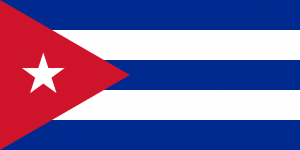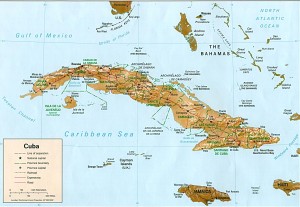 Population of Cuba
Population of Cuba
Based on the total number of births, total number of deaths, net migration rate, and the population of 2013, the current population of the Republic of Cuba is estimated to be about 11,222,261. The Cuban population makes up about 0.16% of the total world population. Its population is 77th in the rankings among all the countries in the world, behind Greece, but ahead of Belgium. It is the fourth-most populous country in North America, behind the United States, Mexico, and Canada. At the end of 2013, the population of Cuba was estimated to be about 11,265,629. Thus, since the start of 2013, the population has decreased by a total of 43,368 people or a population decay rate of 0.38%. Based on the total land area and the total population, the population density of Cuba is estimated to be about 102.13 people per square kilometer or 264.51 people per square mile.
Cuba Population Projection
Based on the birth, death, and migration rates of the Republic of Cuba, by the year 2020, the population is projected to reach 11.097 million people, which is a 0.6% decrease in the population. Then, by 2025, the population will reach 10.989 million people, a decrease of 1.6% from the current population. Continuing this trend, by 2030, the population will sink to 10.84 million people, a decrease of about 2.9% from the current population. Then in 2035, the population will reach about 10.618 million people, decreasing by about 4.9% from the current population. By 2040, the population will have decreased by about 7.4% to 10.336 million people. Lastly, by 2045, the population will have sunk below 10 million people as it reaches 9.956 million people, a total decrease of 10.8% over the next 32 years.
Cuba Demographics
Of the approximate 11.2 million people in the Republic of Cuba, about 51% of the country identifies as mulatto, which is a race of mixed ancestry. About 37% of the population identifies as white, and 11% identifies as black. The last 1% of the population is Chinese. Also, the main language spoken in Cuba is Spanish.
 Geography of Cuba
Geography of Cuba
The total land area of Cuba is 109,884 square kilometers or 42,426 square miles, making it (mainland Cuba) the largest island in the Caribbean and the seventeenth-largest island in the world. It is considered to be an archipelago of islands to the south of Florida in the Caribbean. Most of the geographic features are flat to rolling plains. However, in the southeastern portion of the country, there are the Sierra Maestra Mountains. The highest point in this range is Pico Turquino, which reaches 1,974 meters or 6,476 feet. Lastly, the second-largest island in the Cuban archipelago is the Isle of Youth, which is in the smaller Canarreos archipelago.
Government in Cuba
Cuba is considered to have one of the few remaining socialist states in the world. The Constitution of 1992 cites the influence and guidance by the political and social ideas of people like Lenin and Marx. The Communist Party of Cuba is considered to be the major force of both the government and society. Whoever serves as the First Secretary of the Communist Party serves as the President of the Council of State and the President of the Council of Ministers (or the Premier of Cuba). The President of Cuba is considered to be this First Secretary of the Communist Party and does not have any limits on the number of terms that he can serve. The current President of Cuba is Raul Castro. The legislative body, the National Assembly of People’s Power, elects the President. The National Assembly of People’s Power is also considered to be the major law-making force and source of power. It consists of 609 members that serve five-year terms. Any candidate for the Assembly must be approved through a public referendum. Voting in Cuba is stated to be free, equal, and secret based on the Constitution. Lastly, the People’s Supreme Court is the highest judicial branch in Cuban government. It is considered to be the last resort of any appealed decision from a lower court.
Economy of Cuba
Based on the political structure of the country as a socialist state, the economy also follows socialist principles, mainly through the control of the economy by the state. The majority of the labor force in Cuba is employed by the state. However, there have been major improvements in the number of private employers. Private firms employ about 20% of the Cuban workforce. However, these firms must pay the government the wages or salaries and then the government pays the worker. Also, unemployment stands at only 3.8% of the population. Until August of 2013, Cuba had a dual currency system, where the wages and prices of goods were priced in Cuban pesos, but the tourist economy would depend on Convertible pesos for currency. But, Raul Castro declared the end to that system in 2013. Cuba used to be a dominant power in terms of exports, especially sugar. It used to control 35% of the world’s exports for sugar. However, due to the larger global supply of sugar throughout the world, Cuba is no longer as competitive on the market for sugar and only competes for about 10% of the exports. Lastly, Cuba ranks 177th in the standings of Economic Freedom, just ahead of North Korea.
Religion in Cuba
Originally, the Castro era declared the Republic of Cuba an atheist state in 1962. Because of this, the large Roman Catholic influence on the island was diminished as over 400 schools were shut down. However, in 1992, the state was declared as secular instead of atheist, which allowed people to practice their faiths. The estimates for the actual percentage of the population participates in each faith are a little unclear. However, there did become a large decrease in the Roman Catholic population from before the Castro era to present day Cuba. There is a minor portion of the population that practices Afro-Cuban religions, which combines elements from African religions and Roman Catholicism.
Human Rights in Cuba
Cuba is the only Latin American country to still be on the Human Rights Watch list. The Cuban government, now run by Raul Castro, does not respect the rights of humans as it forces people to conform and accept the unfavorable government. People are beaten, placed in short-term detention center, forced exile, and even given travel restrictions solely as punishment for not conforming to the government. Some prisoners have been released only if they leave the country, however.
Healthcare in Cuba
Every healthcare service in the Republic of Cuba is public and run by the government. There are no privately owned practices or hospitals of any sort. Despite the public healthcare system, the staff of all the facilities is very well trained and has much experience. Historically, Cuba has been known to have one of the best healthcare systems in the world. Despite some hardships down the road due to lack of medical equipment, the Cuban government has been conducting projects to help secure the high status of the healthcare network.
Throughout the years, there has been mixed opinion on the quality of the health care system in Cuba. Along with the economy and education, the health care is completely run by the state and they are financially responsible for the health care of every citizen. Again, similar to education, there are no private health care institutions. One positive aspect of the Cuban health system is the fact that there is one doctor for every 175 people. In Great Britain, there is only one doctor for every 600 people. However, due to the high number of doctors, doctors are not paid as well as they are in other countries. Doctors also have to work in poorly kept facilities and use poorly maintained equipment. If doctors had access to essential drugs, the health care would be better. However, the way that the doctors treat the patients is quite praised. Doctors show a care for the person as a whole and abide by the idea of a triple diagnosis: physical, psychological, and social diagnosis. As of 2011, about 93.8% of the total population uses improved drinking water sources and 92.1% of the population uses improved sanitation facilities. Unfortunately, only 69.9% of the population receives antibiotic treatment for suspected pneumonia. The life expectancy is about 79.1 years with females having a higher life expectancy than males. Lastly, the under-five mortality rate is six deaths per 1,000 children and the infant mortality rate is only four deaths per 1,000 infants.
 Education in Cuba
Education in Cuba
Following the Cuban Revolution, the Cuban government decided to engage in a yearlong campaign effort in order to permanently abolish illiteracy. Before the Revolution, the literacy rate was estimated to be about 60-76% of the population. However, as a result of this campaign, the literacy rate is now 100% of the entire population. Currently, education, school meals, and school uniforms, are considered free for students, regardless of income. It is also compulsory for students from primary schooling until the end of basic secondary education. In order to prevent overcrowding classrooms, there is a maximum of twenty-five students in the primary-school classrooms. There has been an attempt to maximize the number of students in secondary schools to fifteen students. After students complete basic secondary schooling, if they choose to continue school, they attend pre-University education. Education is such a prized and valued asset, especially towards the education of the goals of Cuba. Lastly, the influence of the Communist Party and Fidel Castro resulted in the abolition of private institutions and thus all schools are solely run by the state.
Cuba Census


